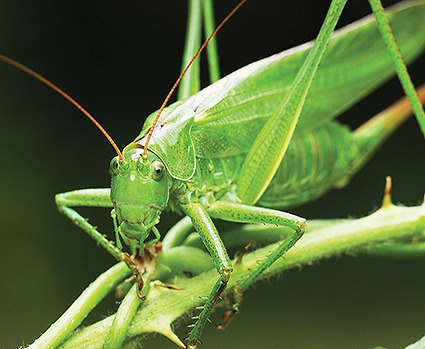Sussex Wildlife Trust: The sound of silence
August 1st, 2020 The Great Green Bush Cricket can claim to be Britain’s biggest insect.
The Great Green Bush Cricket can claim to be Britain’s biggest insect.I’m a huge fan of sci-fi B-movies and they don’t come any better (or worse) than 1957’s Beginning of the End. It’s the usual story; overeager government scientists intent on increasing crop yield inadvertently create giant irradiated grasshoppers the size of doubler decker buses, which set about destroying Chicago. There are some similar creatures lurking around Sussex. OK, they’re not going to come stomping around Sompting any day soon but they’re still mighty impressive.
The Great Green Bush Cricket can claim to be Britain’s biggest insect. Yet this Godzilla of the undergrowth is surprisingly hard to see. Its long, leaf-like body blends in amongst the brambles rendering it almost invisible. Bug eyes, impressive jaws and twirling antennae give it some monster movie credentials but there’s nothing to fear from this harmless native.
There are about 35 species of crickets and grasshoppers (Orthoptera) in Britain. Crickets differ from grasshoppers by having much longer, thread-like antennae and they ‘sing’ by rubbing their wings together (while grasshoppers rub their legs against their wings). This song, or stridulation, is the male’s way of romancing a female – who, if interested, will reply. The best chance of finding the Great Green Bush Cricket is to head out on a warm August evening and listen for their downland duets – a loud, incessant rattle. Imagine an enthusiastic maraca player.
I recently went for a walk through the flower-rich meadows of Sussex Wildlife Trust’s Southerham reserve. I was blown away by the wall of sound created by hundreds of crickets and grasshoppers but it became apparent that not everyone could hear this orthopteran orchestra. The sad truth is that as we get older our ears can’t tune in to the higher frequencies produced by these insects and species by species they fall silent. I have a compilation CD of the chirps and buzzes of Britain’s crickets and grasshoppers – a sort of ‘Now That’s What I Call Stridulation’. I played it this morning and track 24 had gone. It was there a few years ago but now… silence. I’ve started to lose my crickets. The beginning of the end.
It isn’t just me who will be hearing less wildlife in the future. Our countryside is becoming quieter as crickets, bees and birds vanish. Wildflower meadows, the home to crickets and grasshoppers, have been lost and the wildlife that depends on them have silently disappeared. The ‘Silent Spring’ predicted by Rachel Carson in 1962 has seeped across every season. This August, get out and listen to the sounds of summer before they fade.
By Michael Blencowe - Sussex Wildlife Trust is an independent charity caring for wildlife and habitats throughout Sussex. Founded in 1961, we have worked with local people for over half a century to make Sussex richer in wildlife.
We rely on the support of our members to help protect our rich natural heritage. Please consider supporting our work. As a member you will be invited to join Michael Blencowe on our regular wildlife walks and also enjoy free events, discounts on wildlife courses, Wildlife magazine and our Sussex guide book, Discovering Wildlife. It’s easy to join online at www.sussexwildlifetrust.org.uk/join
www.sussexwildlifetrust.org.uk
The Great Green Bush Cricket can claim to be Britain’s biggest insect. Yet this Godzilla of the undergrowth is surprisingly hard to see. Its long, leaf-like body blends in amongst the brambles rendering it almost invisible. Bug eyes, impressive jaws and twirling antennae give it some monster movie credentials but there’s nothing to fear from this harmless native.
There are about 35 species of crickets and grasshoppers (Orthoptera) in Britain. Crickets differ from grasshoppers by having much longer, thread-like antennae and they ‘sing’ by rubbing their wings together (while grasshoppers rub their legs against their wings). This song, or stridulation, is the male’s way of romancing a female – who, if interested, will reply. The best chance of finding the Great Green Bush Cricket is to head out on a warm August evening and listen for their downland duets – a loud, incessant rattle. Imagine an enthusiastic maraca player.
I recently went for a walk through the flower-rich meadows of Sussex Wildlife Trust’s Southerham reserve. I was blown away by the wall of sound created by hundreds of crickets and grasshoppers but it became apparent that not everyone could hear this orthopteran orchestra. The sad truth is that as we get older our ears can’t tune in to the higher frequencies produced by these insects and species by species they fall silent. I have a compilation CD of the chirps and buzzes of Britain’s crickets and grasshoppers – a sort of ‘Now That’s What I Call Stridulation’. I played it this morning and track 24 had gone. It was there a few years ago but now… silence. I’ve started to lose my crickets. The beginning of the end.
It isn’t just me who will be hearing less wildlife in the future. Our countryside is becoming quieter as crickets, bees and birds vanish. Wildflower meadows, the home to crickets and grasshoppers, have been lost and the wildlife that depends on them have silently disappeared. The ‘Silent Spring’ predicted by Rachel Carson in 1962 has seeped across every season. This August, get out and listen to the sounds of summer before they fade.
By Michael Blencowe - Sussex Wildlife Trust is an independent charity caring for wildlife and habitats throughout Sussex. Founded in 1961, we have worked with local people for over half a century to make Sussex richer in wildlife.
We rely on the support of our members to help protect our rich natural heritage. Please consider supporting our work. As a member you will be invited to join Michael Blencowe on our regular wildlife walks and also enjoy free events, discounts on wildlife courses, Wildlife magazine and our Sussex guide book, Discovering Wildlife. It’s easy to join online at www.sussexwildlifetrust.org.uk/join
www.sussexwildlifetrust.org.uk
Comments (0)
No comments have been submitted yet.Why not be the first to send us your thoughts
Leave A Comment
Thank you for your comments, they will appear shortly once approved.
Recent Posts
Have You Seen...






